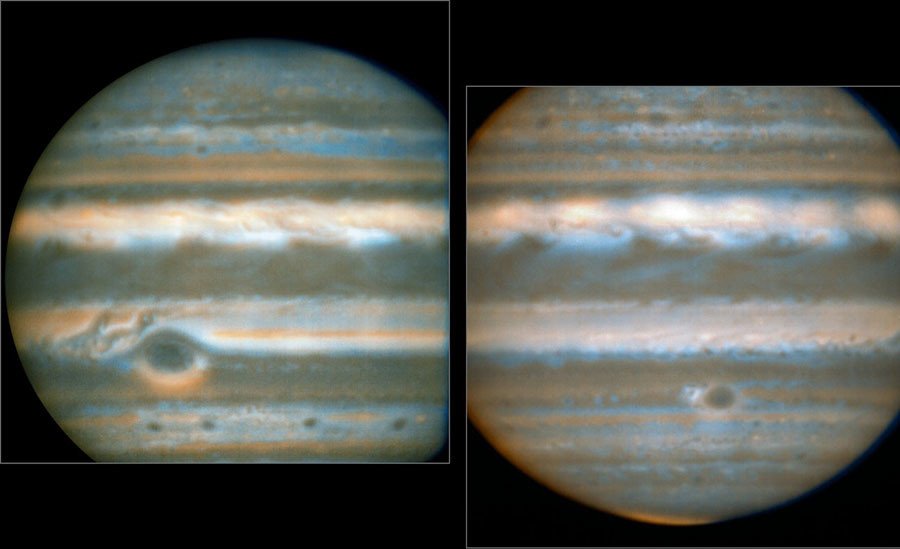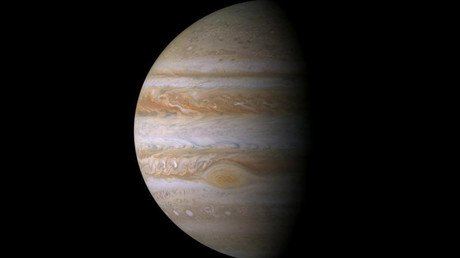Jupiter climate creates amazing fireball images

Dazzling images capturing Jupiter`s weather phenomena and maps offer a unique insight into the internal life of the solar system`s largest planet, showcasing previously unknown wave patterns, giant storms and whirlwinds raving on its surface ahead of NASA`s mission arrival.

The high-resolution imaginary and maps describing Jupiter`s atmosphere were composed using “lucky imaging” technology, which allows to single out the best frames and merge them into the one image thus avoiding the atmospheric blurring interfere with the quality of the shots.
“Individual sharp frames are extracted from short movies of Jupiter to 'freeze' the turbulent motions of our own atmosphere, to create a stunning new image of Jupiter's cloud layers,' said Dr Leigh Fletcher of the University of Leicester that hosted the National Astronomy Meeting devoted to the Jupiter and NASA`s Juno mission held under the auspices of the Royal Astronomical Society from 27 June to July 1.
To obtain the high-quality images and maps the researches at European Southern Observatory employed VISIR, a thermal imager which can operate at infrared. The process of image-taking have spanned for five months, from February to June.
The goal of the project was to “provide the global context for Juno’s close-up views of the planet at the same wavelength,” Fletcher said.

To give an account of the giant planet`s atmospheric events, the scientists secured the help of the TEXES spectrograph on NASA's Infrared Telescope Facility (IRTF) in Hawaii.
It allowed them to devise the first spectral maps of the giant planet which Fletcher thinks will help to envision how Jupiter`s internal life is unravelling and “set the scene for what Juno will witness in the coming months” as it enters the planet`s orbit.
After a 5-year trek, I’m 1 week from #Jupiter. See the trailer for my #July4th orbit arrival https://t.co/nU3cvipV90pic.twitter.com/lcs71gEfUJ
— NASA's Juno Mission (@NASAJuno) 27 июня 2016 г.
“Observations at different wavelengths across the infrared spectrum allow us to piece together a three dimensional picture of how energy and material are transported upwards through the atmosphere,” said Fletcher, adding that in the course of the observation they managed to register a new weather phenomenon occurring on Jupiter.
“These include a widening of one of the brown belts just north of the equator, which has spawned wave patterns throughout the northern hemisphere, both in the cloud layers and high above in the planet’s stratosphere”, Fletcher said, referring to the newly-discovered weather pattern.
The project has united the efforts of both professional and amateur astronomers sending their observations in an attempt to enhance understanding of the ongoing atmospheric processes on Jupiter.
READ MORE:Massive ‘hot Jupiter’ has power to ‘spin-up’ own star, scientists claim
“This dataset will allow researchers to characterize Jupiter’s global thermal structure, cloud cover and distribution of gaseous species,” said Glenn Orton, of NASA’s Jet Propulsion Laboratory, adding that existing findings and data to be obtained by Juno, will help to find out what triggers the atmospheric changes on the planet.
Juno is a NASA mission, named after the deity wife of the ancient Roman god Jupiter and is to enter the planet`s polar orbit on July 4, 2016, after almost five years of wandering space being launched from Cape Canaveral Air Force Station on August 5, 2011.
It is scheduled to orbit Jupiter at just 5,000 km above its clouds withstanding a massive radiation, the closest distance for orbiting ever. Among the spacecraft`s objectives is to study composition, magnetic and gravity field of the planet. It carries three Lego-made aluminum figures on its board - astronomer Galileo Galilei, god Jupiter and Juno.













